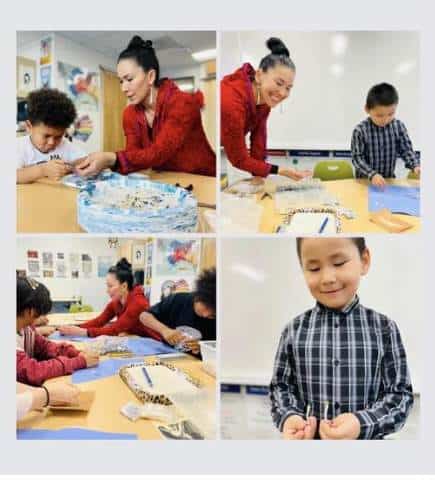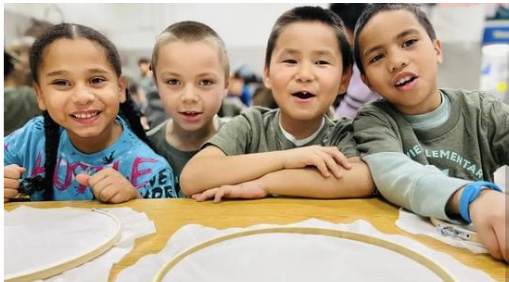Mountain View Elementary Alaska Native Heritage Month
Heritage Project Grant Invited Agreement with Mountain View Elementary, Story by Dr. Clare Hill

The CIRI Foundation is deserving of our gratitude and appreciation in helping empower Mountain View Elementary to celebrate November as an Indigenous Heritage Month. We have used the cultural grant funds to celebrate with eight separately tailored events, some devoted only for our Title VI students and others broadened for whole school assemblies.
Land Acknowledgment
We began the first of the month with a Dena’ina Land Acknowledgement during our nine am morning announcements, which a video recording can be viewed on Mt. View Elementary’s Facebook page.
Atwater Authors
We then welcomed Barbara and Ethan Atwater, authors of How Raven Got His Crooked Nose: An Alaskan Dena’ina Fable and Chia and the Fox Man: An Alaskan Dena’ina Fable. Accompanied with two engaging PowerPoint illustrations, the Atwater’s presented their books at the primary and intermediate assemblies, culminating with a student question-and-answer portion.
Evaluation: The authors mentioned that Barbara used to attend Mt. View herself as a child. She was impressed with our school’s condition and especially our motivational graphic-designed portraits to name a few as Maya Angelou, Lebron James, Barack Obama, and Elizabeth Peratrovich. She expressed interest in returning for a potential next year.
Alutiiq Jewelry
Next, Alutiiq jewelry artist Larita Laktonen-Ward of Kodiak guided our Title VI scholars through making dentalium shell earrings for their families. Generosity, gift-giving, and honoring our elders are indigenous values taught throughout all Alaska and our heritage activities are no exception. Our earring-making scholars were directed into designing and crafting custom jewelry for their parents, grandparents, or other family members. After finishing one for their families, they were allowed to make one for themselves.
Evaluation: A few families mentioned in passing after school when picking up their children that they were impressed that their kids thought to give them authentic jewelry; they thanked our program for teaching them traditional arts and sharing. It wasn’t difficult to instruct our Mt. View students to do something for someone else, but it was difficult to tell them to stop making earrings and go back to their classwork!
Mini Drum-making Activity
An exclusive activity for our Alaskan Native and American Indians, team members from ANHC came to lead them through making mini traditional Yup’ik style drums. It was a large group and arguably one of the more challenging events for the facilitators, chaperones, and me to execute.
Evaluation: This was challenging because of the amount of unexpected dead time our Title VI scholars spent interacting with each other. We had a large group with several stations in the construction process, some stations were quicker than others resulting in a bottleneck of downtime. As all ages, kindergarten through fifth grade, were excited to be together outside of class time, the facilitators and chaperones found it difficult to keep them quiet and respectful. And when they received the finished product, it was even harder for them to keep from beating drums during unseemly times. This is a social and emotional lesson all children will have to toil through in the elementary setting.
ANHC Field Trip
I brought our indigenous scholars to the Alaska Native Heritage Center. There we guided them through village site tours, native games demonstrations, the Heritage Center Dance Team performance, storytelling with elders, a Hall of Cultures tour, and even viewings at their Movie Theater. The students claim this as the most impactful experience.
Evaluation: This is the most beloved and memorable event of the entire month; I still get comments from students asking if we can return! One family of mine has two kids in the Title VI program. Their parents haven’t been back to their village since they were children and were self-conscious and discomforted with the idea, they’ve never shared their heritage with their urbanized children. The mother, and later the father, approached me after the trip in tears. She heartily thanked me for teaching them about her traditions, culture, and homeland; I personally lead our big group through the village site tour. Truly, it was a privilege and honor to be a part of a family’s life-changing moment.
Molly of Denali Visit
PBS’s Molly of Denali came to visit Mt. View in costume during the primary and intermediate all-school assemblies. They watched an episode and after met, hugged, and each class took a group picture with Molly.
Evaluation: It was surprising to see all the third, fourth, and fifth graders sing along to Molly’s opening theme song! It’s one of those circumstances where because of the prior year’s ASD pandemic edicts limiting students from large group assemblies, pent up excitement created a crescendo of jubilation. Some of our teachers even recorded personal video clips of them loudly singing.
Storytelling
Johan Atkinson of Metlakatla captivated our Title VI scholars with illustrious tales and indigenous fables. Dressed in Tsimshian regalia Johan led our youth through stories he himself was told as a child. The challenge was an antiquated one, preventing assembly-deprived children from squirming, touching others, off-topic squills and making indecorous noises.
Evaluation: If I could redo any of our events, this would be it. To say it was challenging keeping our students on-task, quiet, and respectful would be understating. What I would do differently next time would be to modify the event into an all-school assembly, so that their classroom teachers could perform the disciplinary tasks instead of me. We spend more time redirecting them than they spent listening to Johan’s stories.
Elder Talk with Akutaq
We brought Marge, an Inupiaq elder and local kuspuk artist, of Noorvik to give a personal account and story of what subsistence living is like. She touched on traditional hunting and harvesting practices, arts and homestead crafts, village experiences, descripts of northwest Alaska’s aquatic and tundra landscape, traditional northern native values, and the Inupiaq language. Her and her team made Akutaq afterward.
Evaluation: Like the storytelling above, this also was a similarly challenging event. Learning to manage emotions and exercising control of body movements during childhood is always a challenge. If done over again, I would have implemented more stringent consequences for disruptions.
Games and Shavila Presentation
The ANHC NYO Demo team presented an exhibit of indigenous games for our entire school. We covered various aspects of how physical strength, balance, and power helped keep our people fit through the cold winter. As Mt. View will have a JNYO team in February, this event was seasonable and inspirational for team recruitment; this was the most popular whole-school event, the students were especially astounded at the one-foot-high-kick.
Evaluation: There is nothing I’d change; it was original and flawless. On second thought, I’d include more seasoned athletes to up the competition!
Tee-Shirts
One of our goals with our Alaska Native scholars is to instill pride. Thank you to the CIRI Foundation for supporting all of our Alaska Native scholars having tee-shirts to help them remember the month of activities. We see our Native children proudly continuing to wear their shirt.

